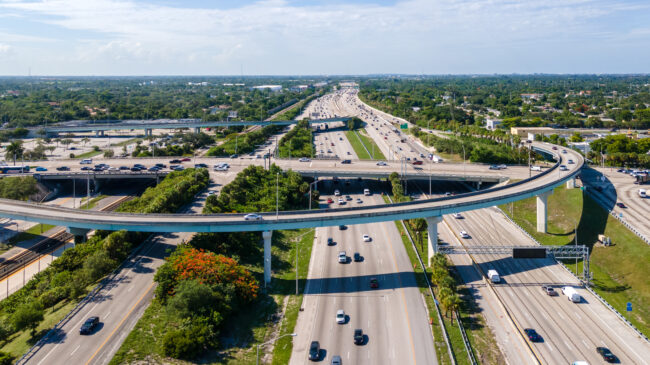States like Hawaii, Utah, Virginia, and Oregon are exploring mileage-based user fees as a long-term, sustainable replacement for fuel taxes. Declining gas tax revenue, the improving fuel economy of vehicles, and the projected long-term growth in the use of electric vehicles underscore the need for a propulsion-agnostic funding source for roads and bridges.
However, mileage-based user fees face implementation challenges due to their expected increased collection costs compared to traditional fuel taxes. While administrative costs per vehicle will be high at the beginning of mileage-based user fee (MBUF) implementation, the collection costs should fall significantly as economies of scale are realized.
Unlike a conventional gas tax, which is imposed only at bulk distribution points like gas stations, some forms of MBUFs require complex mechanisms and technology to accurately record and report mileage for each vehicle. The technology used can vary among states, depending on their specific MBUF collection methods, and this choice can significantly affect collection costs and the public’s perception of mileage fees.
Potential options for MBUF collection include lump-sum payments at annual vehicle inspections and onboard units with GPS receivers that automatically record the vehicle’s mileage, which is then used to calculate the mileage fees owed.
All-electronic tolling, widely used today, may also offer important lessons, especially for reducing per-user collection costs.
Case studies on MBUF pilot programs conducted nationwide also provide insights, particularly the comprehensive final reports from state pilot programs. Hawaii’s Road User Charge (RUC) demonstration was initiated to address declining fuel tax revenues and the state’s increasing number of electric vehicles, which do not use gas and thus don’t pay gas taxes.
For its pilot program, Hawaii took mileage and fuel consumption readings during a participating vehicle’s annual inspection. The state found in its final report that if implemented on a mandatory basis, the collection costs of the RUC model would be less than 5% of the revenue generated by the road user charges, placing the system “on par with other modes,” such as fuel taxes.
Oregon took a broader approach to its mileage-based user fee (MBUF) collections. The Oregon Department of Transportation (ODOT) has investigated MBUFs since 2006. During a 2012 pilot program, Oregon residents and participants expressed concerns about privacy intrusions arising from location-based collections, and the Road User Fee Task Force in Oregon incorporated that feedback. The state then offered customers a choice in recording their mileage and making their payments. Oregon’s open system offered four options:
- Basic plan: Devices reported a vehicle’s mileage and fuel consumption to ODOT without any location information.
- Advanced plan: GPS-enabled devices reported a vehicle’s miles to Sanef, a private account manager, which only assessed charges for distances on Oregon public roads.
- Smartphone plan: A smartphone app offered two reporting options: all miles driven without location information or location-based reporting for only Oregon miles driven. This was also managed by Sanef, the private contractor, not the state.
- Flat fee: ODOT charged motorists a $45 per month fee (equivalent to around 3,000 miles driven) or $135 for three months of pilot participation with no locational data involved.
For a program this diverse, the collection costs were a major concern. Oregon reported that the collection costs of its commercial-run light-vehicle road user charge program represented a massive 40% of the revenue generated (which was paid to third-party vendors). However, ODOT indicated it would need to negotiate a lower rate when the program became mandatory and expanded to cover other vehicles.
Oregon’s Program & Project Report on past pilot programs and the establishment of a permanent RUC program highlighted an alternative avenue for lowering implementation and collection costs: private-sector participation.
If the small-scale pilot had collection costs consuming 40% of the revenue generated, how could greater participation help lower costs further? The answer lies in economies of scale. The costs per customer would be much lower in a mandatory, permanent RUC program (as Oregon has established). Oregon’s pilot program should stand as proof of concept, not necessarily a model to aim for cost-wise.
Oregon’s report noted that private providers could supply mileage reporting devices, manage payment processing, and provide account management services, which would reduce costs incurred by the state. Partnering with other states would also help realize economies of scale faster, provide a larger market, and deliver more competition, all of which would help reduce costs.
Despite these potential solutions, collection and administrative costs remain a concern for states considering mileage-based user fees. Many back-office administrative costs are relatively fixed, meaning per-customer costs will initially be higher due to those administrative costs being spread over a small number of users, as shown by Oregon’s small-scale pilot. However, with technological advancements and economies of scale, costs can be expected to decline over time, as Utah’s Road Usage Charge Report noted.
As a state’s mileage-based use fee customer base grows, its unit costs should fall, and current collection cost concerns should be reduced. But more research is still needed. A key area of study is finding ways to further lower collection costs to be more comparable to the current fuel tax administrative costs.
As a 2012 Reason Foundation report noted, the true collection cost of the fuel tax is likely within 3%-to-5% of revenue generated, on par with efficiently managed all-electronic tolling systems. This should be the rough goal of a fully deployed mileage-based user fee system aiming to replace gas taxes.

